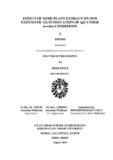Please use this identifier to cite or link to this item:
http://archive.nnl.gov.np:8080/handle/123456789/316| Title: | Effect of some plant extract on non enzymatic glycosylation of IgG under in-vitro conditions |
| Authors: | Yadav, Dinesh Prasad |
| Keywords: | AGEs-induced IgG Diabetes Hyperlipidemy IgG Advanced glycation end products |
| Issue Date: | 10-May-2018 |
| Abstract: | Medicinal plants are used in rural India to treat diabetes due to their traditional acceptability and availability. The plants are used as a crude extracts or as mixtures to treat diabetes. Plant extracts have their own importance and now being studied extensively due to having little or no side effects. Protein glycation takes place when elevated levels of reduced sugars react with amino groups in proteins, reaction known as Maillard reaction. If this process continues, it will lead to the formation of complex, often unstable, irreversible and reactive compounds “AGEs”, a process that may take weeks or even months to accomplish. The present study demonstrates that presence of AGEs-induced IgG damage in type 1, type 2 diabetes and hyperlipidemic patients. The study further purposes that in addition to IgG in serum concentration the quality of IgG molecule may not only be a crucial feature affecting its immunologic effects but also a risk factor as AGEs damage in diabetic and hyperlipidemic patients. The present study also provided evidence to suggest that the glycation of isolated IgG from diabetes and hyperlipidemic patients lead to alteration in the conformational as well as the biological properties of IgG. Further in present study Eulophia campestris and Eulophia nuda was selected and used to check the Maillard reaction inhibitory activity. Different combinations of glucose, protein and plant extracts (Eulophia campestris and Eulophia nuda) were made under in vitro conditions and their activity were monitored with trichloro acetic acid treatment method at 350 nm. Maillard reaction products/ AGEs were more with high glucose and high protein concentration and these were decreased by highest concentrationof Eulophia campestris and Eulophia nuda extract i.e. 30 mg/mL or 300 μL. Lower concentrations of plant extract produced either no or least response against Maillard reaction. |
| Description: | A thesis submitted in partial fulfillment for the award of the degree of Doctor of Philosophy in Bioscience (Biochemistry), Gyan Vihar School of Bioscience Suresh Gyan Vihar University, India, 2012. |
| URI: | http://103.69.125.248:8080/xmlui/handle/123456789/316 |
| Appears in Collections: | 500 Natural sciences and mathematics |
Files in This Item:
| File | Description | Size | Format | |
|---|---|---|---|---|
| 133. Dr. Dinesh Prasad Yadev.pdf | 3.02 MB | Adobe PDF |  View/Open |
Items in DSpace are protected by copyright, with all rights reserved, unless otherwise indicated.